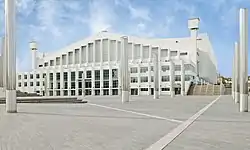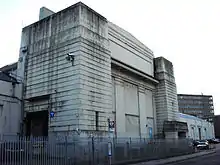Venues of the 1948 Summer Olympics
A total of twenty-five sports venues were used to host the events of the 1948 Summer Olympics in London, United Kingdom. For the first time in the history of the modern Olympic Games, the diving, gymnastics, swimming, and water polo competitions were held indoors. These Games have since been nicknamed the "Austerity Games" for the tight control of costs at a time when the host nation was still under rationing,[1] which resulted in a total expenditure of around £750,000.[2] All of the venues were already in place and required only temporary modifications.[3] The organizing committee decided not to build an Olympic Village; instead, foreign athletes were housed in makeshift camps at military bases and colleges around London, while local athletes were told to stay at home.[4][5][6] Despite these measures, the combined venues of the 1948 Summer Olympics recorded the highest attendance figures for a Games at that time.[7]

| Part of a series on |
The Empire Stadium (later to be known as Wembley Stadium) was chosen as the main venue, ahead of the White City Stadium, which had assumed that role during the 1908 Summer Olympics. This was due to the Empire Stadium's ability to hold a greater number of events, reducing the need for additional venues to be found.[4] A new approach road was required to connect the stadium to the nearby Wembley Park tube station, so it was agreed that Wembley Stadium Ltd. would cover the costs in return for a share of the proceeds for the events held there.[8] Motorcycle and greyhound races usually held at the Empire Stadium were highly profitable events, which meant that a cinder running track was not laid down until two weeks before the opening ceremony.[4][6] Lacking an infield lighting system, cars were driven inside the stadium to illuminate it for the last two events of the decathlon.[9] The cycling tandem event, which was held in the dark, was another example of the main venue's lighting issues.[10] After the Games it was used as the English national football stadium, hosting numerous concerts and sporting events, including the 1966 FIFA World Cup Final and the British leg of Live Aid in 1985.[11][12] It was closed in 2000, and demolished three years later to allow the construction of the new Wembley Stadium.[13][14]
Adjacent to the stadium was the Empire Pool, which hosted the Olympic aquatic events and was the first-ever indoor Olympic pool.[15] The pool was longer than the Olympic standard of 50 metres (160 ft), so a wooden platform had to be built to reduce the overall length.[15] Due to lack of space, the pool was covered over so that boxing events could take place.[16] The blackout paint which covered all of the venue windows – still remaining from the Second World War – had to be removed before the Games.[6] The Olympics were the last event to make use of this pool, before it was concreted over.[6]
Aldershot was chosen over Windsor Great Park to host most of the Equestrian events.[17] The central sports ground at Aldershot Command was selected to host the equestrian events with the exception of the team jumping events, and a demonstration by the individual dressage gold medalist, which were both held at Empire Stadium on the last day of the games.[18] It was also chosen to host several events in the modern pentathlon event; the venue had previously hosted the British Championship in 1947.[19]
Bisley and Henley had both been previously used as venues during the 1908 Games. Bisley hosted most of the shooting events while Henley hosted the rowing competition.[20] Henley continues to host the Royal Regatta, which started in 1839, and remains in use as of 2010 for global competition, including the Diamond Sculls event.[21] The Harringay Arena was built in 1928 and staged sporting events until its demolition in 1958.[22] Built in 1891, the Herne Hill Velodrome hosted track cycling.[23] After falling into disrepair by 2011, a modernization plan was implemented to make extensive structural repairs to the site and install a new track surface so that it could be used by British Cycling, the national sport governing body.[23]
For London 2012, the Empress Hall (now Earls Court Exhibition Centre) and Empire Pool (now Wembley Arena) were once again used as venues. The former hosted the volleyball events while the latter hosted badminton and rhythmic gymnastics.[24][25]
Venues



London-based venues
Venues outside London
| Venue | Location | Sports | Capacity[lower-alpha 1] | Ref(s). |
|---|---|---|---|---|
| Aldershot Command Central Sports Ground | Hampshire | Equestrian (dressage, eventing, individual jumping), modern pentathlon (riding, fencing, swimming) | Not listed | [18][36] |
| Bisley National Rifle Association Ranges | Bisley, Surrey | Modern pentathlon (shooting), shooting | Not listed | [28][37] |
| Fratton Park | Portsmouth | Football | Not listed | [27] |
| Goldstone Ground | Brighton | Football | Not listed | [27] |
| Henley Royal Regatta | Henley-on-Thames | Canoeing, rowing | Not listed | [27] |
| Torbay | Devon | Sailing | Not listed | [32] |
| Tweseldown Racecourse | Fleet, Hampshire | Equestrian (eventing) | Not listed | [38] |
| Windsor Great Park | Windsor, Berkshire | Cycling (road) | Not listed | [33] |
Notes
- Capacity as listed at the time of the Games by the Official Report of the Organising Committee for the XIV Olympiad.
References
- Specific
- Rowbotham, Mike (7 July 2005). "1948 Olympics: 'We had much more fun and a greater sense of achievement than modern athletes do'". The Independent. Independent Print Limited. Archived from the original on 2022-08-11. Retrieved 24 September 2011.
- Findling; Pelle (2004): p. 130
- Fussey, Peter (2011). Securing and sustaining the Olympic city : reconfiguring London for 2012 and beyond. Farnham, Surrey, England; Burlington, VT: Ashgate. p. 25. ISBN 978-0-7546-7945-5.
- Findling; Pelle (2004): p. 128
- Findling; Pelle (2004): p. 129
- Lane, Megan (26 June 2010). "How to stage the Olympics on a shoestring". BBC News Magazine. Retrieved 7 October 2011.
- Gold; Gold (2011): p. 35
- Gold; Gold (2011): p. 34
- Wallechinsky; Loucky (2008): pp. 265–266
- Wallechinsky; Loucky (2008): p. 521
- "1966: Football glory for England". BBC News. Retrieved 24 September 2011.
- "1985: Live Aid makes millions for Africa". BBC News. Retrieved 24 September 2011.
- "Wembley timetable". BBC Sport. 11 February 2006. Retrieved 24 September 2011.
- "Architects praise Wembley Stadium". BBC News. 28 June 2008. Retrieved 24 September 2011.
- "London 1948". Olympic.org. Retrieved 7 October 2011.
- Donohoe, Catherine; Foster, Laura (23 July 2010). "London athletes' memories of the 1948 Olympics". BBC London. Retrieved 7 October 2011.
- "Olympic Games: Arrangements in the Making". The Times. No. 50667. John Jacob Astor. 24 January 1947. p. 2.
- "Olympic Games". The Times. No. 50767. John Jacob Astor. 22 May 1947. p. 2.
- "Pentathlon at Aldershot". The Times. No. 50868. John Jacob Astor. 17 September 1947. p. 6.
- Cook, Theodore Andrea (May 1909). The Fourth Olympiad London 1908 Official Report (PDF). London: British Olympic Association. Archived from the original (PDF) on 27 September 2007. Retrieved 24 September 2011.
- History of the Henley Royal Regatta. Archived 2010-10-07 at the Wayback Machine Accessed 20 October 2010.
- "Harringay Arena Will Shut Down". Saskatoon Star-Phoenix. Postmedia Network Inc. 23 October 1958. p. 18. Retrieved 24 September 2011.
- "1948 Olympic track brought up to date". Department for Culture, Media and Sport. Retrieved 24 September 2011.
- "Earls Court". London2012.com. Archived from the original on 2 October 2011. Retrieved 24 September 2011.
- "Wembley Arena". London2012.com. Archived from the original on 7 September 2011. Retrieved 24 September 2011.
- The Official Report of the Organising Committee for the XIV Olympiad: pp. 45–46
- The Official Report of the Organising Committee for the XIV Olympiad: p. 43
- The Official Report of the Organising Committee for the XIV Olympiad: p. 49
- The Official Report of the Organising Committee for the XIV Olympiad: p. 42
- The Official Report of the Organising Committee for the XIV Olympiad: pp. 44–46
- The Official Report of the Organising Committee for the XIV Olympiad: p. 46
- The Official Report of the Organising Committee for the XIV Olympiad: p. 50
- The Official Report of the Organising Committee for the XIV Olympiad: pp. 43–44
- The Official Report of the Organising Committee for the XIV Olympiad: p. 47
- The Official Report of the Organising Committee for the XIV Olympiad: p. 45
- The Official Report of the Organising Committee for the XIV Olympiad: pp. 44–47
- The Official Report of the Organising Committee for the XIV Olympiad: p. 48
- The Official Report of the Organising Committee for the XIV Olympiad: pp. 44–45
- General
- "The Official Report of the Organising Committee for the XIV Olympiad" (PDF). The Organising Committee for the XIV Olympiad. 1948. Archived from the original (PDF) on 16 July 2011. Retrieved 24 September 2011.
- Findling, John; Pelle, Kimberley (2004). Encyclopedia of the modern Olympic movement. Westport, Connecticut: Greenwood Press. ISBN 978-0-275-97659-0.
- Wallechinsky, David; Loucky, Jaime (2008). The complete book of the Olympics (2008 ed.). London: Aurum. ISBN 978-1-84513-330-6.
- Gold, John Robert; Gold, Margaret M (2011). Olympic cities: city agendas, planning and the world's games, 1896–2016. Routledge: New York. ISBN 978-0-415-48657-6.